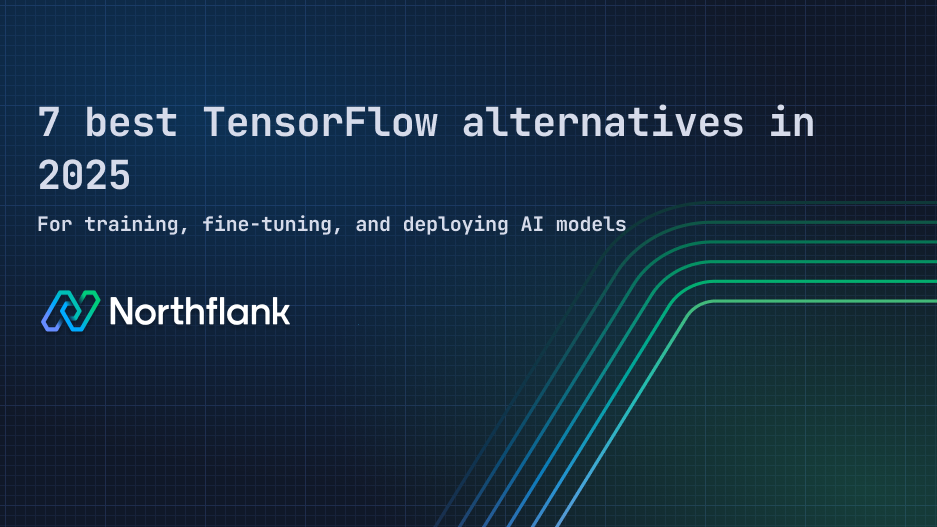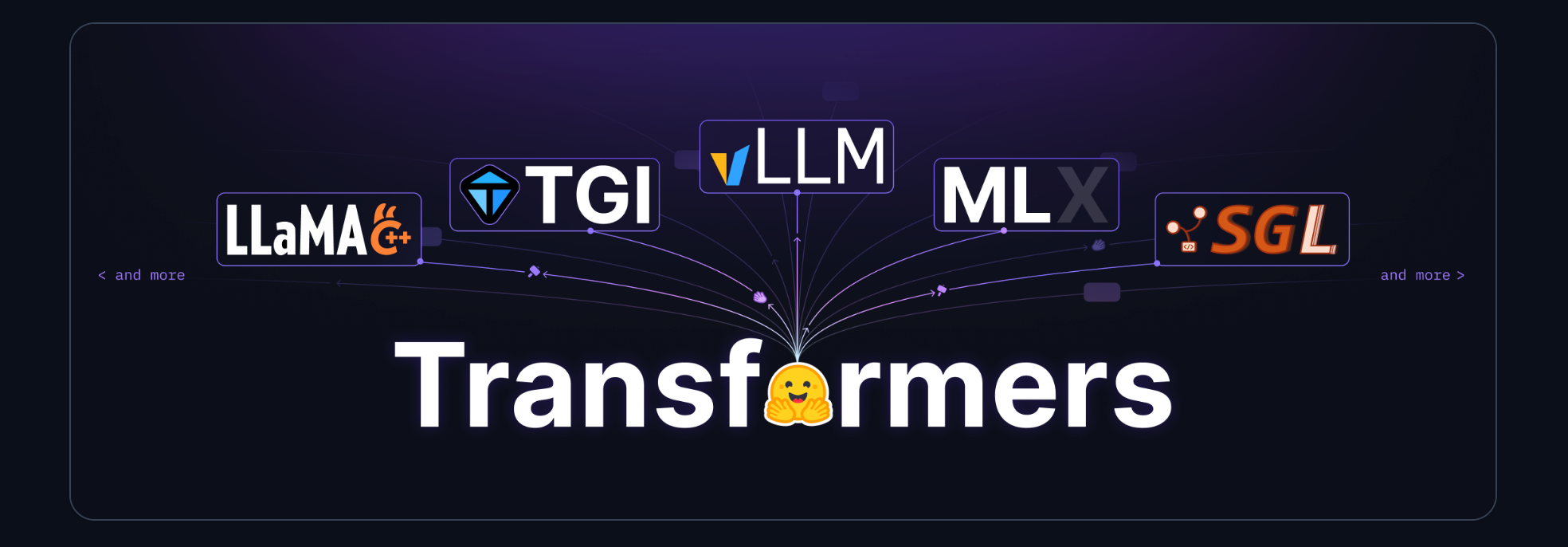

7 best TensorFlow alternatives in 2025 for training, fine-tuning, and deploying AI models
If you’re in search of TensorFlow alternatives, you're likely comparing PyTorch, JAX, Hugging Face, or even platforms like Modal. However, if you’re looking for something that goes beyond frameworks and can help you train, fine-tune, deploy, and scale your models, then Northflank should be your go-to.
That moment when your team starts working with production workloads like fine-tuning LLMs, running background jobs, or exposing APIs, and you begin to run into the constraints of TensorFlow.
Can you relate? What happens when your needs grow beyond what the framework was built for?
So many teams like yours end up working around things that should already be taken care of.
For example, being locked into a static graph model and spending more time debugging than you should.
Or running into issues when trying to integrate with tools like Hugging Face or DeepSpeed.
And at that point, what’s missing becomes obvious: GPU orchestration, a secure runtime, CI/CD, and a way to deploy models alongside the rest of your application.
That’s when the question comes up: what are the alternatives?
You’ve got PyTorch, which gives you more flexibility. JAX, for performance control. Hugging Face, with thousands of ready-to-run models.
And then there are platforms like Northflank, which let you move past local notebooks and run your entire AI stack on GPUs you control, using the same workflow you’d use for any backend service.
So in this guide, I’ll walk you through the best TensorFlow alternatives in 2025. Some are frameworks. Some are infrastructure platforms. All of them solve problems that TensorFlow alone doesn’t.
Now that you’ve seen some of the reasons why teams like yours look for alternatives to TensorFlow, I’ll give you a quick comparison to see how the alternatives compare to each other.
Before you look at the table, you should know that some of these tools give you more control at the framework level. Others handle infrastructure, so your team doesn't have to build around the same problems again and again.
💡If your team needs infrastructure that supports the full lifecycle from training and fine-tuning to CI/CD and serving API, Northflank is the only option on this list that gives you all of that out of the box.
That said, if your use case is focused purely on experimenting or building with a specific framework, the open-source tools still offer plenty of flexibility; you’ll need to pair them with the right infrastructure layer, like Northflank or something similar, depending on how much control you want over deployment and scaling.
Save your time and get started for free or book a demo to speak with an expert.
See the table below:
| Tool | Type | GPU training support | Fine-tuning capabilities | Deployment & Infra support | Open Source availability |
|---|---|---|---|---|---|
| Northflank | Platform | Supported across providers | Supported for LLMs and custom models | Full-stack support including CI/CD, jobs, APIs, databases | Not open source |
| PyTorch | Framework | Widely supported | Native support for fine-tuning workflows | Requires manual setup for deployment and infra | Fully open source |
| JAX | Framework | Supported on GPU and TPU | Requires additional tooling for fine-tuning | Requires custom infra for deployment | Fully open source |
| Hugging Face Transformers | Library over PyTorch | Built-in for supported models | Fine-tuning support out of the box | Can run locally or on managed infra | Partially open source (core library is open, some enterprise tools are proprietary) |
| PyTorch Lightning | Framework | Built on top of PyTorch | Designed for structured fine-tuning | Deployment available via Lightning AI platform | Fully open source |
| DeepSpeed | Training optimizer | Optimized for large models | Advanced fine-tuning capabilities | No built-in deployment, requires separate infra | Fully open source |
| Modal | Platform | Supported with serverless jobs | Limited compared to full frameworks | Deployment for Python functions with GPU access | Not open source |
If you need a detailed comparison, scroll down.
Once you’ve seen how the different tools compare, the next step is knowing what to prioritize based on how your team works.
Are you focused on model experimentation, or are you thinking ahead to deployment and compliance?
Some of the main things teams tend to look for when searching for TensorFlow alternatives:
-
Dynamic vs. static computation graphs
Tools like PyTorch and JAX give you more flexibility with dynamic execution, compared to TensorFlow’s static graph approach.
-
Easier debugging and more intuitive APIs
When you're deep in model development, every hour spent debugging adds up. Frameworks with cleaner, Pythonic interfaces tend to win here.
-
Compatibility with popular tools
Integrations with libraries like Hugging Face, DeepSpeed, and Ray can speed up your workflow and give you access to thousands of ready-to-use components.
-
Scaling across GPUs and workloads
If your team is training massive models or running multiple fine-tuning jobs in parallel, you’ll want tools that support horizontal scaling. Northflank handles this directly by letting you run jobs across GPU-powered services without needing to manage infrastructure manually.
-
Support for deployment workflows
Think CI/CD, secure API endpoints, inference scheduling, and background workers. Northflank supports these natively, while frameworks often require extra tooling to cover these areas.
-
Security, audit logs, and compliance
For teams running models in production, you’ll need runtime isolation, fine-grained access controls, and visibility into what's running. Northflank includes audit logs, secure environments, and secrets management out of the box.
-
Open-source flexibility vs. full platform coverage
You’ll need to decide how much infrastructure your team wants to handle. Tools like PyTorch and JAX give you full control. Platforms like Northflank remove that burden so your team can focus on building and shipping.
Now that you’ve seen the comparison table and what to look for, let’s break down each alternative a bit more clearly. We’ll cover what each one is, how it compares to TensorFlow, and when it might be the right fit for your team.
Some of these are open-source frameworks that give you fine-grained control when training and experimenting.
Others are platforms that take care of orchestration, infrastructure, and deployment, so your team can move faster without integrating multiple tools manually.
Depending on what your team is building, you might find yourself combining one or two of these tools. That’s why it helps to know what each one handles well and where you’ll need to plug in additional systems, unless you're going with a platform like Northflank that already includes the infrastructure piece.
Northflank is a platform that supports the full lifecycle of AI workloads, from training and fine-tuning to deployment and scaling, while also managing the infrastructure around them, including CI/CD pipelines, GPU provisioning, secure runtimes, background jobs, and built-in databases.

You can bring your own GPUs or provision them on-demand across supported providers. The runtime is secure by default, isolating workloads and blocking unsafe container behavior and network access.
It’s built to support tools you're likely already using, like Hugging Face, PyTorch, DeepSpeed, Jupyter, and LLaMA, with templates and building blocks that make them easy to run in production.
You also get infrastructure included, so you don’t have to manage those layers separately:
- CI/CD pipelines and container builds built into every project
- On-demand and bring-your-own GPU support across AWS, GCP, Azure, and more
- Secure-by-default runtime to prevent container escapes and unsafe networking
- Built-in services like Redis, Postgres, object storage, and cron jobs
- First-class support for background jobs, vector DBs, and model APIs
- Templates for common AI tools, including Hugging Face, DeepSpeed, LLaMA, Jupyter
Go with this if you want to deploy, train, fine-tune, and manage infrastructure in one place without having to connect multiple tools manually.
See how Cedana uses Northflank to deploy workloads onto Kubernetes with microVMs and secure runtimes
PyTorch is a widely adopted deep learning framework known for its dynamic computation graph, which makes it easier to experiment, debug, and iterate, particularly compared to TensorFlow's static model.

It’s the default choice for many research teams and production systems because of how flexible and intuitive it is to work with.
You’ll find useful integration with other open-source tools in the ecosystem:
- Hugging Face Transformers run natively on PyTorch, making model deployment and experimentation faster
- DeepSpeed works well with PyTorch for distributed and optimized training
- PyTorch Lightning helps structure and scale complex models while keeping flexibility
Go with this if your team wants full control over training and fine-tuning, and you're building your own stack from the framework up.
See this guide on What is PyTorch? A deep dive for engineers (and how to deploy it)
JAX is a high-performance numerical computing library with a NumPy-like syntax and first-class support for function transformations like jit, vmap, and grad.
It’s designed for high-throughput workloads on GPUs and TPUs, and is widely used in advanced research environments like DeepMind.

While the learning curve is steeper than PyTorch, it gives you detailed control over how computations are structured and run.
Here’s where JAX tends to be a good fit:
- Function-level transformations like
jitfor speed,vmapfor batching, andgradfor autograd - Built-in hardware acceleration with deep integration for TPU and GPU workloads
- Popular in research settings where custom setups and performance tuning are common
Go with this if you’re building custom training loops or experimenting at research scale and need full control over execution.
Hugging Face Transformers is a popular library that gives you access to thousands of pretrained models across NLP, vision, and audio tasks.
It now focuses entirely on PyTorch, with training, fine-tuning, and serving utilities built around tools like accelerate, optimum, and DeepSpeed.

It’s widely used by teams who want to avoid starting from scratch and get to production faster.
Here’s what makes it useful:
- Thousands of pretrained models covering a wide range of tasks
- Performance integrations with DeepSpeed,
optimum, andaccelerate - Built-in utilities for tokenization, datasets, and fine-tuning workflows
Go with this if you want fast access to high-performing models and a smoother path to fine-tuning or serving them with PyTorch.
See 7 best Hugging Face alternatives in 2025: Model serving, fine-tuning & full-stack deployment
PyTorch Lightning is a high-level framework built on top of PyTorch that helps teams structure and scale training code without rewriting core logic.
It’s used by teams that want to run experiments at scale, organize training runs, and eventually turn research code into production workflows.

Some of the features that make it practical:
- Clear structure for training loops, model checkpoints, and logging
- Works with Fabric and DeepSpeed for performance optimization
- Built for repeatability, making it easier to share and maintain training code
Go with this if you're building repeatable training pipelines or turning research projects into production-ready modules.
DeepSpeed is an open-source optimization library developed by Microsoft, designed to support large-scale training and fine-tuning of transformer-based models.
It’s commonly used in LLM workflows and multi-billion parameter model training where performance and memory efficiency are critical.

Some of the features teams rely on:
- ZeRO (Zero Redundancy Optimizer) optimization for sharding model states across devices
- Offloading techniques to move computation and memory to CPU or NVMe
- 3D parallelism support for tensor, pipeline, and data parallel training
Go with this if you need to fine-tune large models with better GPU memory efficiency and distributed training capabilities.
Modal is a closed-source, serverless platform designed for running Python-based GPU jobs without managing infrastructure directly.
It’s often used for lightweight tasks like batch inference or model training in the cloud, especially when speed and simplicity are the goal.

What to keep in mind:
- Serverless model abstracts away most infrastructure details
- Built-in support for Python-based GPU workloads
- Missing core features like persistent databases, CI/CD workflows, and secure runtime customization
Go with this if you want a quick way to run jobs in the cloud and don’t need deeper infrastructure control.
See 6 best Modal alternatives for ML, LLMs, and AI app deployment
Now that you’ve seen what each alternative offers, the decision often comes down to this:
Do you need full control at the code level, or are you looking to get your workloads running in production without spending weeks on infrastructure?
Here’s how to think about it:
- Frameworks like PyTorch, JAX, and DeepSpeed give you deep control over model architecture, training loops, and experimentation. They’re open-source and widely adopted, but they don’t come with deployment, orchestration, or security layers.
- Platforms like Northflank and Modal handle the infrastructure for you. That includes provisioning GPUs, setting up CI/CD, serving models, managing databases, and securing workloads, so your team doesn’t need to build all that from scratch.
In practice, most teams use both:
A framework for training and fine-tuning, and a platform to handle everything else once it’s time to ship.
Northflank supports both directions, bring your own framework and we’ll take care of the infrastructure, so you can stay focused on building.
Once your team has chosen a framework that fits your training and experimentation needs, the next step is determining where to run everything reliably, securely, and without compromising your own infrastructure.
That’s where Northflank comes in.
Teams use Northflank to deploy and manage their entire AI stack, including fine-tuning models, serving APIs, and running jobs in production.
Here’s what you get:
- Run fine-tuning jobs, notebooks, and background workers with GPU support
- Built-in observability: logs, metrics, deploy history (no separate tools needed)
- SOC 2 alignment, role-based access control, audit logs, and tenant isolation for production workloads
- Bring Your Own Cloud (BYOC): deploy to AWS, GCP, or spot GPU marketplaces like RunPod and Lambda
- Templates for Hugging Face, LLaMA, Jupyter, Postgres, Redis, and more to get started quickly
- Everything in one place with a clean UI, robust API, and GitOps support for teams that want automation
See the docs to get started.
If you’ve made it this far, you’ve most likely seen how frameworks like PyTorch and JAX differ from TensorFlow, and how platforms like Northflank fit into the bigger picture.
To wrap up, here are some common questions that come up when teams begin evaluating alternatives:
-
What is the replacement of TensorFlow?
PyTorch and JAX are two of the most common alternatives today. Many teams also pair these with platforms like Northflank to handle deployment and infrastructure.
-
Which is better: PyTorch or TensorFlow?
PyTorch is generally preferred for flexibility and dynamic graphs, while TensorFlow may suit teams already deep in its ecosystem. Most newer projects lean toward PyTorch.
-
Is TensorFlow still relevant in 2025?
Yes, but it’s no longer the default. Many AI teams use PyTorch or JAX and prioritize frameworks that integrate better with modern tooling.
-
Can I deploy Hugging Face models without TensorFlow?
Absolutely. Hugging Face supports PyTorch and JAX, and works well with platforms like Northflank for model serving.
-
Is Modal open-source?
No. Modal is a closed-source platform focused on running Python functions with GPU access.
-
Is TensorFlow shutting down?
No. TensorFlow is still maintained by Google, but its popularity has shifted as more teams move to PyTorch.